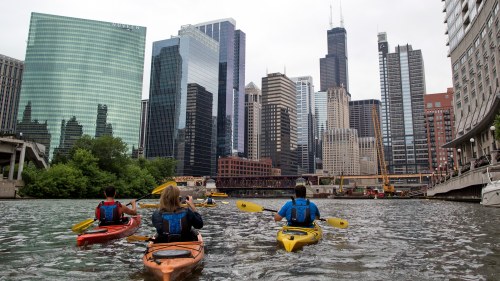'A stinky ditch': How Chicago, Beijing, and Paris are making their rivers swimmable

How did Paris, Chicago, and Beijing's rivers get so dirty, and what do their cleanup efforts have in common?
The Chicago River, more than many urban rivers, has been contorted to fit the city. Engineers reversed the river’s natural flow around 120 years ago to push sewage downstream. Since then, the river has been polluted by meat industry kill floors, invaded by carp, and befouled by Dave Matthews’ Band’s tour bus poop.
Despite these very gross challenges, Chicago is one of several major cities around the world that’s promised to make its rivers swimmable. Chicago made the pledge back in 2016, saying swimmers would be able to dip into the river by 2030.
After a 100-year ban on river swimming, Paris’s 2024 Olympic games plan to host swimming events in the Seine. And in Beijing, locals spent this historically hot summer cooling off in a revitalized river that was once a drainage ditch for horses.
So how did Paris, Chicago, and Beijing’s rivers get so dirty, and what do their cleanup efforts have in common?
Why was the Seine so nasty?
In the mid-1800s, Napoleon III’s city planner George-Eugène Haussmann built huge boulevards, designed parks, and demolished medieval homes in poor, overcrowded districts.
Haussmann also redesigned Paris’s sewer system. Previously, the city’s inefficient and insufficient sewers made it one of the deadliest in Europe. It was regularly rocked by cholera outbreaks from contaminated water.
Haussmann’s sewer system combined pipes for sanitation and stormwater runoff into a single network. That worked really well — most of the time.
When Paris was hit with heavy rains, all the sanitation waste ran in the same pipes as the stormwater draining from the city streets. Too much rain overwhelmed the system, and the wastewater and runoff drained into local waterways like the Seine, which runs through the heart of Paris.
This waste, combined with other sources of urban pollution, made the Seine so dirty that it’s been illegal to swim in the river for the last 100 years.
That finally changed this summer. After more than $1 billion was spent on modernization and restoration projects, Parisians can legally swim in the Seine again.
City officials spent years expanding Paris’s underground rainwater reservoirs. Now, during a big storm, rainwater is diverted from the sewage system into basins that hold up to 10 million gallons of rainwater. Then the rainwater heads to a treatment plant. After it’s cleaned, the water returns to the river.
“Nothing in Paris’ plan is unique,” Robert Traver told TIME. “But to do it is unique.” Traver is an urban river specialist and professor at Villanova University.
Can Chicago replicate Paris's success?
Chicago is a very different city than Paris, but it essentially has the same problem. Like Haussmann’s network, Chicago’s sewer system combined wastewater and stormwater into a single system. By some estimates, rain overwhelms the system, on average, once a week. That means that about every six days, untreated sewage drains into the Chicago River.
And climate change is projected to exacerbate the problem, as it has this summer. By 2050, Chicago is expected to get an extra 2.5 inches of rain each year.
Chicago’s solution is essentially the same as Paris’s, and it’s been in the works since the 1980s. For decades, the city has been building huge rainwater tunnels and reservoirs called the Tunnel and Reservoir Plan, or TARP.
The largest reservoir, located on the city’s west side, was almost 70% finished at the end of last year. It should be finished by 2029, one year before the 2030 swimming goal.
TARP McCook Reservoir is nearing completion! When complete it will provide flood protection for people in 37 communities & improve water quality in the Chicago Area Waterway System & our rivers and streams by preventing combined sewer overflows. #infrastructure #floodprotection pic.twitter.com/GkcfqOeNzP
— MWRD (@MWRDGC) November 9, 2017
Once the reservoirs are complete, the city’s sewer system won’t flood nearly as easily, though it’s not a perfect fix. Torrential rainfall could still overwhelm the system, but it’s likely to happen much less often.
In addition to massive stone reservoirs, Chicago is relying on natural solutions to help clean up the river.
For nearly a decade, a group of local NGOs has partnered with the city to develop the Wild Mile, a series of floating plant beds and reeds that will, one day, ring Goose Island on the west side.
That area was once a shipping hub into and out of the heart of Chicago. Industry replaced the plant life that once lived on the river bank, but Wild Miile is now putting it back.
Wetland plants filter river water by soaking up pollutants that would otherwise remain in the river. This process, called phytoremediation, can lead to cleaner rivers and improve biodiversity by creating habitats for fish and other wildlife.
The project currently covers about 12,000 square feet, or just about 10% of the goal, but it’s slowly expanding.
Subscribe to ChicagoGlobal
This story first appeared in the ChicagoGlobal newsletter, a joint project of Crain's Chicago Business and the Chicago Council on Global Affairs.
"Wilder and wilder": Beijing rethinks its rivers
Except for a few, brave retirees who occasionally took a dip in Beijing’s Liangma River, cooling off with a swim in the river would have been unimaginable a few years ago.
The Liangma didn’t start out as a river. In imperial China, the Liangma was just a few ditches near the city’s imperial stables and the intersection of some old man-made waterways that flowed out of the city. Horsetraders washed down their animals and let them dry in the sun before taking them to market or showing them to imperial buyers.
Centuries later, the ditches were expanded in the 1980s to improve drainage for Beijing’s growing Chaoyang district. Embassies, malls, and luxury hotels started popping up in the neighborhood as it developed.
While this was good for the local economy, it wasn’t good for the river. Following in the hoofprints of the horse traders before them, taxi drivers parked by the riverside and used the water to clean off their cabs. Water drained off of the commercial district streets and into the Liangma without being treated.
Development continued, but Beijing’s city government recognized it had a problem. All the malls, hotels, and luxury buildings had left the Liangma “broken, incomplete, and unsystematic,” Shen Tongshen told Renwu. Shen helped design the river’s restoration project.
I used to pass by the Liangma river a lot. This was what the river looked like before the renovation. It’s changed a lot now. pic.twitter.com/yCiD1XSx9g
— Ruihan Huang (@ruihan_huang) July 19, 2023
Shen wanted to build infrastructure and recreation around the river, not just next to it. He started thinking about “embedding them (waterways) in people’s everyday lives.” But then he started rethinking what a “modern” riverfront really meant.
Previously, Beijing city officials wanted lush public spaces with grass and flowers all year-round. But Beijing is a northern city with a dry climate and cold winters. As the city government became more climate-conscious, the idea of a “modern and clean” riverfront also changed.
Like the planners of Chicago’s Wild Mile, Shen lined the Liangma with wetland berths, reeds, willows, and pagoda trees. Instead of planting flowers, he is slowly letting the land “get wilder and wilder.” Now, he can let the reeds die in winter and turn yellow.
“People still need this kind of wildness,” he explained.
The restoration of the Liangma is just one of many water system projects in Beijing. Shen envisions a connected string of pearls that opens up pedestrian traffic alongside waterways in the notoriously congested city.
“Now, we are connecting water, green, and people,” he said. “The city should look good, not ugly. And not look like a stinky ditch.”
With clean rivers, will would-be swimmers change their minds?
City planners can use rewilding and reservoirs to make rivers swimmable, but that doesn’t mean residents will actually swim in them. Most Parisians still think of the Seine negatively, using words like “dirty,” “polluted,” and “smelly” to describe it.
Still, Beijing’s river revitalization shows that when river revitalization is designed for everyday use, people can change their attitudes about the rivers.
The Chicago River cleanup still has about seven years until it’s projected to be completed, so there’s still plenty of time to change hearts and minds.
This story first appeared in the ChicagoGlobal newsletter, a joint project of Crain's Chicago Business and the Chicago Council on Global Affairs. Subscribe today.

